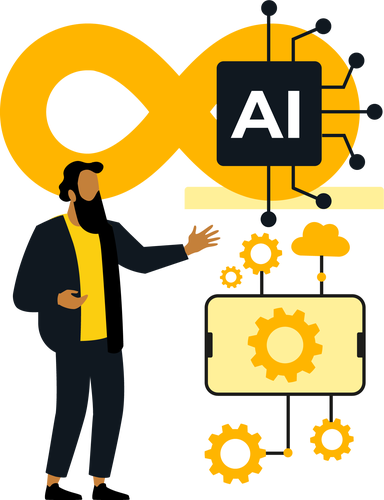Marko Klemetti,
CTO of Eficode
Guide
How to become an AI Native software organisation
The Eficode AI Adoption Framework and AI Success Roadmap

The future of software development is AI Native
Software development is changing. Fast.
Not just in how we write code, but how we build, operate, and evolve software systems from end to end.
AI tools like GitHub Copilot, Amazon Q, GitLab Duo, and others are already showing real productivity gains in software development. Teams release faster, fix bugs faster, make less mistakes, and automate more. But even though the tools exist, adoption and integration of those tools are suboptimal.
This is not a technology problem. It’s a practical one.
We see it often. Teams get stuck in pilots, governance is unclear, security becomes a bottleneck, and the business value is hard to measure. Many companies don’t have a plan for how AI will change their software lifecycle or their ways of working.
This guide is for those who want to fix that.
We’ll go through the real blockers and introduce the framework we use at Eficode to drive AI adoption. It’s built to take you from assistants and early experiments to fully AI-powered software delivery—step by step.
The goal is not to hype AI. It’s to make it work and ensure your competitiveness as AI Native.


For easy reading, receive this guide as PDF by e-mail
Contents
Part 1. Setting the scene
Part 2. AI Adoption Framework
- Introducing the Eficode AI Adoption Framework
- Eficode AI Adoption Framework
- PHASE 1: AI-enhanced developer productivity and software modernization
- PHASE 2: AI-powered software agents (Single-agent workflows)
- PHASE 3: AI-orchestrated software lifecycle (Multi-agent workflows)
- PHASE 4: AI integrates software, product and business workflows
- PHASE 5: AI Native in software and business thinking
PART 1
Setting the scene
Everyone agrees AI is the future. But very few are ready for it.
AI tools are already delivering real benefits in software development. Productivity is up. Releases are faster. Routine work is being automated. Most tech leaders agree AI will reshape how software is built and operated.
Yet very few companies are moving beyond isolated pilots. The problem isn’t the technology. It’s everything around it: Strategy, governance, integration, and ownership.
This is the AI paradox: The potential is clear, but progress is slow. The question remains. Why?

McKinsey, Forrester
60% of software teams using AI see significant productivity gains.

Microsoft
45% faster software releases with AI-assisted development.

McKinsey
91% of organizations say they are not fully prepared for AI adoption.

Gartner
85% of IT leaders say AI integration into development workflows is more difficult than expected.

To read and share this guide easily, get this guide as a PDF
No clear ownership
AI touches
development, operations, and security.
But who leads?
Stuck in pilots
AI usage remains limited to
individual tools or teams, with no strategy for
scalability.
Security and compliance concerns
Without guardrails, AI feels risky rather than
helpful.
Lack of governance
No clear policies or structures to support responsible AI use.
Fragmented tooling
Developers use different assistants without support, integration, or shared knowledge.
Missing business case
Leaders struggle to connect AI usage to measurable business value.
PART 2
AI Adoption Framework
Why do we need a framework?
Most organizations don’t struggle with AI because of the tools. They struggle because they don’t know what comes next.
They start small, usually by enabling a few developers with coding assistants. But without a structure to grow from that starting point, momentum stalls. There’s no shared vision for scaling AI across the team, let alone across the company. Roles are unclear. Governance is missing. Leadership wants results, but doesn’t see the full picture. There isn’t a way to anticipate and plan for what’s next.
That’s why we built the Eficode AI Adoption Framework.
It provides a clear, phased approach to adopting AI in software development based on how AI is rapidly evolving. Each phase builds on the one before it. It helps technical and business leaders speak the same language. Most importantly, it turns AI from a scattered experiment into a part of how software gets built, delivered, and improved across the entire lifecycle.
This framework is based on real-world experience. We’ve worked with companies that are just getting started and with those already exploring multi-agent systems. We’ve seen what works, what doesn’t, and what it takes to move forward with confidence.
AI assistants are a good start,
but without structure and
governance, they remain isolated
tools. The real value starts when
AI becomes part of the life cycle.”
Henri Terho
AI Adoption Lead, Eficode


For easy reading, receive the PDF version by e-mail
The starting point for AI adoption
This is where most companies begin their journey with AI in software development. It’s a practical phase, focused on improving day-to-day development work with the help of AI assistants and preparing the software architecture for more advanced automation later on.
At this stage, AI is not autonomous. It supports the developer, helping with tasks like writing code, creating tests, generating documentation, or detecting bugs. Developers still make the decisions, but they start to benefit from faster feedback, fewer manual steps, and a better development flow.
At the same time, many organizations realise that parts of their system landscape aren’t ready for automation. Legacy systems, outdated pipelines, and inconsistent tooling often stand in the way. That’s why modernization is a critical part of this phase. Modern codebases and toolchains give AI the right environment to work in.

Laying the groundwork for value
The focus here is on creating real usage, not just experimentation. AI assistants like GitHub Copilot or Amazon Q are introduced in controlled settings. Teams define policies, test capabilities, and start collecting early feedback. There’s a learning curve involved, so internal enablement is key. A few good developer champions can make a big difference.
At the same time, this phase is where companies often face their first governance questions: What data can be used with these tools? What code can be generated and committed? Should we track AI usage? These are important discussions, and it’s better to start them early.
Even if the business case at this stage is modest (mostly time savings and happier developers), it builds trust and momentum, and proves AI can be useful without being risky—setting the stage for broader automation.
What success looks like:
- AI assistants are being used in daily development across the team.
- Developers feel confident and supported in using the tools.
- Code quality improves through AI-assisted testing and documentation.
- Legacy blockers are being removed, starting with the highest-friction areas
- Internal guidelines for AI usage are in place and understood.
- There’s a shared sense of progress, and appetite to move to the next level.
Moving from assistants to autonomy
In Phase 2, organizations move beyond AI as a passive assistant and begin using it to actively automate specific tasks. This is where AI agents come in—software components that can execute work on behalf of the team, often integrated into CI/CD, testing, infrastructure, or security workflows.
Unlike AI assistants that wait for human prompts, agents operate based on triggers or workflows. They can run tests, provision infrastructure, manage documentation, or scan for vulnerabilities. Developers still validate and approve, but the agents start to carry more of the load.
This shift increases efficiency and consistency, while also requiring more structure: how agents are built, how they’re monitored, and how their output is governed.

Building trust and control into agent-based automation
Introducing agents raises important questions: What decisions can they make? What actions require human approval? How do we track what they’ve done?
To succeed in this phase, organizations need to balance automation with oversight. Clear policies, logging, and feedback loops help teams stay in control. At the same time, the underlying systems—pipelines, permissions, testing environments, and more—must be robust enough to support automation without introducing risk.
Teams also begin experimenting with Retrieval-Augmented Generation (RAG), combining company-specific data with LLMs to make AI agents more useful and context-aware.
What success looks like:
-
AI agents automate parts of CI/CD, testing, documentation, or infrastructure workflows.
-
Teams have clear policies for where human approval is required.
-
Changes made by agents are traceable and auditable.
-
RAG systems start to provide internal knowledge to improve AI responses.
-
Automation leads to measurable time savings and fewer manual errors.
-
Teams are confident in what agents do and ready to scale up their usage.

For easy reading, receive this guide as PDF by e-mail
Connecting agents into a coordinated system
Phase 3 marks a major shift from isolated automation to orchestration. Instead of a single agent running tests or generating documentation, multiple AI agents now interact across the software lifecycle. They work together, communicate through shared data layers, and operate with minimal human involvement.
In this setup, an AI agent might detect a code change, trigger another agent to run tests, and then inform a third agent to update documentation or deploy the feature. The system acts more like a collaborative team than a collection of tools.
This phase delivers bigger efficiency gains, but it also requires stronger architecture, observability, and governance.

Treating AI like a team member
Multi-agent workflows introduce complexity. When several AI systems interact, it becomes critical to track what happened, why, and when. Logging, explainability, and shared context are essential.
This is also where many companies start to evolve their internal roles and processes. Developers shift toward validating and improving workflows, not just writing code. Platform teams design safe execution environments. Security and compliance functions become part of the pipeline, not blockers to it.
Done right, AI becomes a full member of the software delivery team, capable of acting, learning, and adapting based on feedback.
What success looks like:
-
Multiple AI agents collaborate across the lifecycle (e.g., code → test → deploy → document).
-
Shared data and coordination layers allow agents to act on each other’s outputs.
-
Human involvement shifts toward oversight, tuning, and exception handling.
-
Security, compliance, and observability are built into every workflow.
-
Teams operate with greater speed and fewer manual bottlenecks.
-
There is a clear structure for managing and evolving agent workflows.
AI-supported software meets the rest of the business
AI is already used in many parts of the organisation—marketing, service operations, customer support, and beyond. What changes in Phase 4 is how AI-powered software delivery starts to connect with those areas.
Here, AI agents don’t just support development. They also generate product documentation, marketing assets, compliance reports, or user insights as part of the same workflow. A feature release might now trigger actions across multiple departments, all driven by the same underlying logic.
This phase is about integration. Software delivery becomes part of a connected, cross-functional system where AI drives value from code to customer.

Cross-functional value flows, automated
The key enabler in this phase is coordination. AI-generated outputs must be meaningful for different teams—technical, business, and customer-facing. That means shared data, shared platforms, and shared understanding of how AI agents contribute to each step.
It also means that human roles start to shift again. Product teams begin focusing more on steering outcomes than managing handoffs. Developers gain visibility into customer impact. AI helps close the loop between what’s built and how it performs in the market.
This level of integration is not only technical; it’s cultural and operational. But when done right, it eliminates many manual steps and improves both speed and alignment.
What success looks like:
-
Software releases trigger coordinated actions across product, marketing, and support.
-
AI-generated outputs (e.g., GTM content, security docs, user insights) are used cross-functionally.
-
Development teams work with real-time customer and usage data.
-
Product analytics and feedback loops are integrated into the delivery pipeline.
-
Governance and compliance are handled across both technical and business layers.
-
AI connects teams, reduces handoffs, and speeds up time-to-value
Software that evolves itself
In Phase 5, the software lifecycle becomes fully AI Native. Instead of AI supporting delivery, it drives it. AI agents continuously design, test, deploy, and adapt software based on real-time business goals and customer behaviour.
This phase is not about doing the same work faster—it’s about changing how work gets done. The role of humans shifts entirely. Teams guide direction, ethics, and product strategy. AI handles execution. Software becomes a self-improving system that learns, adapts, and evolves in production.
This level of transformation blurs the line between product and business operations. The software is no longer an output—it becomes an active part of how the company runs.

Autonomous workflows, strategic humans
AI agents in this phase operate as interconnected systems. They collaborate across the stack—from backend code to customer-facing assets—and connect technical execution with business impact. Product analytics, real-time feedback, and usage data drive how software changes automatically.
Humans move up a level. Instead of managing tickets, they manage goals. Instead of assigning tasks, they define boundaries. This shift also demands new ways of thinking about governance, trust, and accountability.
Companies that reach this stage don’t just move faster—they operate differently. Their business models evolve. Their organizations become adaptive. And their ability to respond to change becomes a competitive advantage.
What success looks like:
-
AI agents autonomously run the full software lifecycle.
-
Systems adapt continuously based on user behaviour and business goals.
-
Humans define direction, ethics, and value—not implementation.
-
Product changes happen in response to real-world signals, not backlog items.
-
Governance is proactive and built into the system itself.
-
The organisation operates like an adaptive system, learning in real time.

For easy reading, receive this guide as PDF by e-mail
What does a normal Tuesday as an AI Native software company look like?
07:32
A product lead gets a notification: customer satisfaction scores dropped 5% in onboarding flows. She doesn’t panic.
07:34
An AI agent already analyzed user behaviour and identified the pain point. Another agent has generated three design alternatives and tested two of them on 200 live users overnight.
07:41
The most successful variant shows a 14% improvement. An update to production is ready for review. Documentation, release notes, and an internal feature video are already drafted by agents.
08:10
The team reviews and approves the release with a single click. Compliance is covered. AI-based security validation has already passed.
08:30
AI-generated data visualizations suggest adjusting marketing content. The business team gets fresh messaging based on real usage patterns.
10:00
The PM drinks her coffee, thinks about the next strategic move, and smiles. The software is evolving on its own.
Read about GenAI use cases
Phase 5 isn’t science fiction. It’s what happens when you take AI out of the lab and put it into the software lifecycle—where it actually delivers value"
Kalle Mäkelä,
AI Lead at Eficode
PART 3
Growing pains and the way forward with AI
Why AI adoption stalls
AI adoption in software development rarely fails because of the technology. It stalls because organizations struggle to move beyond early experiments. Across industries, we see the same patterns repeat. These are not unique failures—they’re common growing pains. Recognizing them is the first step toward solving them.
Stuck in proof of concepts
Many organizations start with pilot projects testing AI assistants, building a few scripts, or trialing tools like Copilot or ChatGPT. But nothing moves forward. There’s no defined path to scale, no operational plan, and no metrics to show success. The pilots stay isolated, and eventually, momentum fades.
Tool chaos
When AI starts to spread organically, teams adopt whatever tools seem useful. One team uses Copilot, another tests GitLab Duo, someone else builds their own prompts. Without coordination, it creates confusion. There’s no support model, no consistency, and no shared learning across teams.
Leadership buy-in without a roadmap
Executives are often excited about AI. They want to “do more with AI” or “put Copilot in place.” But enthusiasm without structure leads to a disconnect. Technical teams lack the necessary discipline. Business leads expect results. And the gap between ambition and execution grows.
Security and compliance friction
One of the fastest ways to stall AI adoption is to ignore governance. If security, legal, and compliance teams aren’t involved early, their concerns will block progress later. Questions around data privacy, source code integrity, auditability, and licensing need clear answers from the start.
No clear ownership
AI adoption cuts across functions it touches development, operations, security, product, and sometimes marketing or legal. But in many companies, no one is explicitly responsible for driving it forward. Without ownership, decisions get delayed, and opportunities are missed.
AI will fundamentally change how software is developed and operated. That transformation must be owned by your teams, your developers, and your business. But building AI Native capabilities inside an organisation isn’t a task for experimentation alone. It requires experience in: Automation, DevOps, platform thinking, and change management. Experience that takes years to build. At Eficode, we’ve spent two decades helping companies automate, modernize, and evolve their software delivery. What AI brings is a new layer on top of that foundation, and a new opportunity to get it right from the start.

The Eficode AI Adoption Framework redefines software development as a journey and presents clear, manageable phases. It provides language, direction, and alignment between teams, allowing companies to move from experimentation to scale, with confidence—all while anticipating the changes in AI’s ability itself. But how you get to your desired progress depends on the stage you are in now. Three stages of capability building:
Foundation: Align and prepare
Every successful journey starts with clarity. The foundation stage is about understanding where you are, aligning leadership, and preparing your systems and teams. It’s where direction is set and early wins are created. At this stage, the focus is less on tools and more on building a shared understanding of AI’s role in software development. It’s also the moment to surface blockers in tools, practices, or mindset before they become problems later.
Acceleration: Enable and scale
Once direction is clear, the focus shifts to enablement. In the acceleration stage, developers begin using AI in real workflows. Legacy systems are modernized. Governance and guardrails are introduced. This is where momentum is built, not through one-off experiments, but by integrating AI into the daily work of software delivery. Practices are established, results are tracked, and confidence grows across teams.
Execution: Operate and evolve
Execution is where AI becomes a natural part of how the organisation runs. It’s no longer a project; it’s infrastructure. AI connects development, product, business, and operations. Teams begin working with adaptive systems instead of static pipelines. Human roles shift toward steering and oversight. At this stage, the organisation doesn’t just adopt AI—it runs with it, using it to evolve continuously and create real competitive advantage.
Introducing the AI Success Roadmap: Strategic offering by Eficode
Foundation
to optimise current AI use
AI for leadership
Training and demo for leaders on potentials for using AI to create efficiency to software development.
AI Discovery and Roadmap
AI value stream mapping and software hackathon to create a detailed roadmap for AI adoption.
Experiment in AI Lab
Rapidly test and build AI solutions with your data, expert support, and NVIDIA-powered infrastructure.
Acceleration
to take AI to the next level
AI agents and assistants
Build AI assistants and agents with Atlassian Rovo, GitHub Copilot, Amazon Q and Bedrock, GitLab Duo, or NVIDIA Agentic platform.
AI developer masterclass
Effective implementation of coding assistants and agents—programs for GitHub Copilot, GitLab Duo, and Amazon Q.
Software modernization
Using Amazon Q, GitHub Copilot, or selected AI assistants, modernize legacy software with test automation and DevOps practices.
Execution
to scale AI for ROI
AI roadmap adoption
Build an adoption program to get the full benefits of AI in software development.
Implementation resources
DevOps consulting in Azure AI, GitHub Copilot, GitLab Duo, Amazon Q and Bedrock, and purpose-built AI environments.
Platform engineering
Building AI capabilities for developers using platform engineering. A fast, controlled, and cost-effective way of adopting AI in software.

For easy reading, receive this guide as PDF by e-mail
AI is changing how software is developed. That’s clear to most companies already. The harder question is how to adopt it in a way that actually works—and lasts.
We’ve seen how these kinds of changes play out. When Agile or DevOps came in, the technology wasn’t the problem; it was how organizations responded. Old ways of working were deeply rooted. Teams were busy. Leadership wanted results but didn’t always know what to expect. With AI, it’s no different. But there’s another layer of complexity: The speed of which AI is evolving. Which needs to be anticipated—and planned.
Adopting AI isn’t just installing a tool or running a few pilots. It’s about how decisions get made, how people collaborate, and how learning happens in everyday work. That’s where the real impact is, but also where the biggest challenges are.
The most common pattern we see is this: Teams try out AI tools, maybe run some successful experiments, but there’s no plan for what comes next. Governance is missing. Tooling is fragmented. No one is sure who owns the responsibility. Everyone is interested, but progress is slow. This doesn’t even take into account anticipating possible improvements and developments in AI itself.
That’s not a failure of effort. It’s what happens when change doesn’t have enough structure behind it.
That’s why the timing now matters. Not because of hype or pressure, but because AI gives us a reason to stop and think about how we want to build software in the future. It creates space to reflect: Are we ready to work differently? Are we set up to learn fast? Do we have the right foundations?
In the end, AI adoption isn’t just a technical shift, it’s an organizational one. The companies that succeed are the ones that treat it as a capability to build over time. Not all at once. But step by step. With structure, with ownership, and with the confidence to challenge what already works.

Henri Hämäläinen,
Head of DevOps and AI at Eficode





